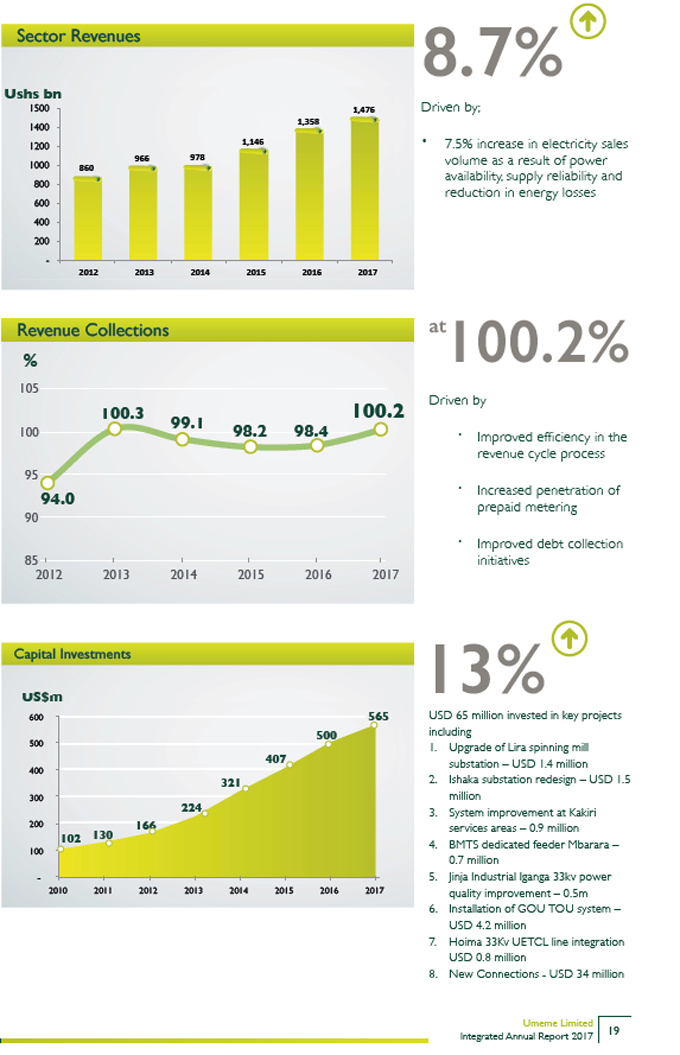Umeme improves services
The power distributor also revamped its contact centre through the provision of many online customer digital channels, including the UmemeApp.
Umeme's promise to customers is to be an efficient supplier of safe, reliable electricity and friendly customer experience. The power distributor's strategy has always been focused on process simplification, automation and investments to improve network performance.
Over the years, Umeme concluded the integration of payment platforms with all the major financial institutions, mobile money operators and sale service points.
"Going cashless on all our retail outlets greatly improved our operating efficiencies, improved the customer experience and freed some resources tied to cash management work stream," Selestino Babungi, the Umeme managing director, explained.
The power distributor also revamped its contact centre through the provision of many online customer digital channels, including the UmemeApp. This has resulted in a 56% reduction in voice calls and growth in other digital communication platforms. Umeme continues to be open and accessible 24/7, at the service of its customers.
The company continues to review its customer service processes to ensure they are less cumbersome and deliver a faster service experience.
By end of 2017, the power utility's customer base closed at 1,125,291 of which 70.1% are on prepaid metering (Yaka).
"The plan is to convert the remaining households from postpaid to prepaid metering in the next one year," Babungi said.
Umeme's industrial customers require continuous quality electricity supply, for industrial production.
The reliability improvement projects, under implementation, are projected to improve the quality and reliability of supply.
Some of the key projects implemented to reduce outages include the Moniko substation in Lugazi, Nyakesi substation in Tororo to cater for the Tororo Cement Industries expansion plant, and the National Cement Company and Hima Cement, the two new cement plants setting up in Tororo, distribution automation, integration lines, Luweero-Kapeeka lines and distribution infrastructure protection schemes.
There are also the technical engineering service zones for the customers to minimize travel times and prolonged outages. Also the development of an Asset Master Plan, was concluded and the company has commenced implementation of ISO 55000 on assets management.
Over the last 12 years, Umeme's investments in the distribution infrastructure have led to the doubling of the physical infrastructure, improved efficiencies, tripling of customer connections, supply reliability and improved customer service.
"As a result, the electricity supply industry is financially stable, with minimal government subsidies," Babungi added. Increased grid expansion and access to electricity contributes to Uganda's economic development and improves social services like education, health and household incomes.
Umeme realizes that the government's ambition of increasing electricity penetration from current 23% (of which 16% is on the grid) to 40% of households by 2025, coupled with the projected increase in effective generation capacity from the current 650MW to over 1,600MV by 2020, underlines the urgency for investments in the distribution network.
As such, the company estimates an investment of $1.2 billion over a 10-year period to achieve the government objective. "Mobilisation and deployment of this capital shall be an important work stream for the company over the coming period.
Continuous investment in the grid ensures its efficiency, reliability, safety and ability to evacuate and distribute increased generation capacity," Babungi explained.
The utility has made tremendous improvements in its domestic and industrial service delivery with its Yaka game changer revolution mainly for domestic, commercial and government customers, with up to 70% of the customer base on prepayment billing, cashless with over 16 partnering commercial banks, mobile money services, Eezymoney and PayWay.
The introduction of SCADA/ intelligent network watchdog, which helps in detecting faults on the network and also helps in quick supply restoration, reduction in outages, Automated Meter Reading (AMR) for large consumer users, e-bills and SMS bills, all of which have offered customers a better experience by giving them the power to manage and control their consumption and bills. The company has also improved its technical capabilities, organisational development, engineering, human resource and contractor capabilities.
AMR benefits
Umeme has injected approximately $18m in the Automated Meter Reading (AMR) technology to support its operations at metering installations as well as protect the revenue from of the industrial and commercial customers.
AMR is a technology of remote collection of consumption and other meter data to a central location for billing, troubleshooting, and analysis for management and operational decision making. Remotely reading meters results in operational efficiency, enhanced customer service, as well as accurate and timely billing.
The three phase industrial and commercial customers account for over 70% of Umeme's sales and revenue albeit being just about 2.0% out of a total customer database.
As such, they contribute significantly to the company's performance.
Through the project, the existing old metering installations are replaced with AMR installations in the same location. Where the AMR infrastructure is installed customers are provided with a web access portal from which they can view their consumption profiles and billing information.
"The advantages of AMR over the old installations include the timely detection of energy theft, enhanced safety around the meter installations as well as improved customer service through timely detection and resolution of faults," Babungi noted.
To-date, approximately 3700 old meter installations have been retrofitted with AMR technology since 2014. Through this investment, nearly 50 GWh has been recovered from the new AMR installations, which translates into savings of $6 million for the electricity sector over the three years.
The deployment of the technology has also shortened Umeme's monthly billing cycle run from 14 days to an average of seven days hence the customers receive bills earlier and can pay on time.
Industrial customers are able to compute different metrics for their internal analysis such as computing the cost of power per unit of production, power supply status over a period of time et cetera via the AMR web access portal.
